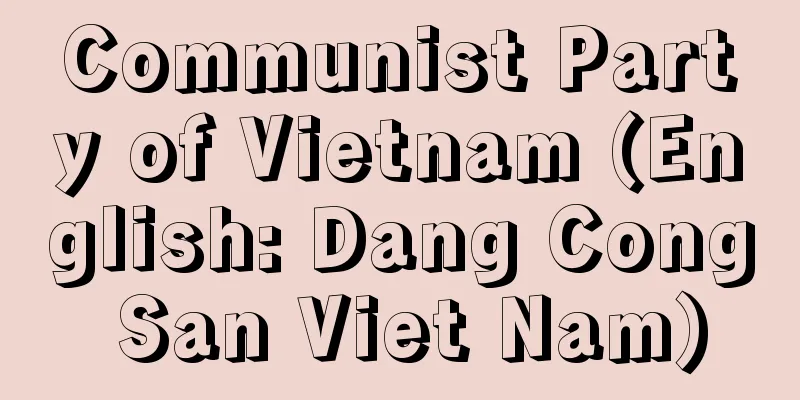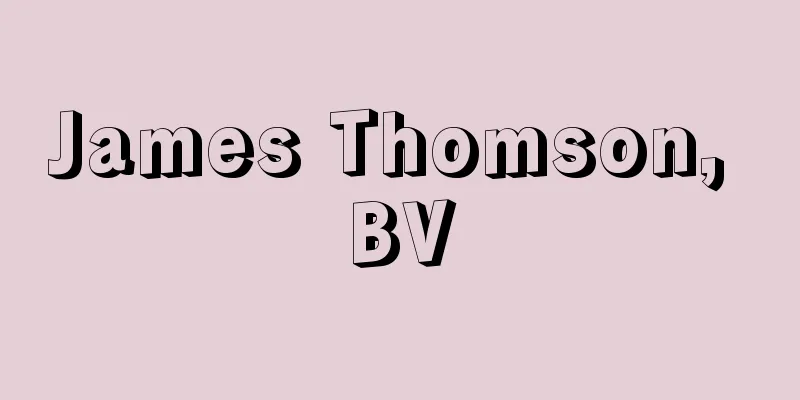Communist Party of Vietnam (English: Dang Cong San Viet Nam)

|
A political party in the Socialist Republic of Vietnam. It was founded on February 3, 1930 in Hong Kong (Kowloon) by uniting various communist factions in Indochina under the presidency of Ho Chi Minh (then Nguyen Ai Quoc). It has since served as the leading party in the Vietnamese Revolution. Article 4 of the current constitution, adopted in 1992, stipulates that the Nation is "the force that leads the state and guides society." When the party was first established, it was called the Communist Party of Vietnam (Viet Nam Cong San Dang), which is the Chinese name, but in October 1930, under the direction of Comintern (Third International), it was renamed the Communist Party of Indochina. After the August Revolution of 1945, it was temporarily disbanded in order to avoid a crisis for the new government established under the party's leadership, but at the 2nd National Congress (held in Tuyen Quang) in February 1951, it was renamed the Workers' Party of Vietnam and resumed open activities. At the 3rd National Congress held in Hanoi in September 1960, the party set the ultimate goal of unifying Vietnam, which had been divided into North and South since the Geneva Accords were signed in 1954, and decided to actively support the liberation struggle in the South as well as the socialist construction in the North. Ho Chi Minh was the party's supreme leader until his death in September 1969, but after his death, a collective leadership system was established centered on General Secretary Le Duan, Truong Chinh, and Phan Van Dong. On April 30, 1975, the North Vietnamese Army and the Southern Liberation Front launched an all-out attack and succeeded in liberating the South, and at the 4th National Congress held in Hanoi in December 1976, the party was renamed the Communist Party of Vietnam (Dang Cong San Viet Nam), using the Vietnamese name. After the 1979 war with Democratic Kampuchea under the rule of Pol Pot and the People's Republic of China, the country maintained particularly friendly relations with the Communist Party of the Soviet Union. However, the turmoil and collapse of the communist regimes in the Soviet Union and Eastern Europe in the second half of the 1980s led to a major revision of its previous course of socialist construction. At the 6th National Congress in December 1986, the party adopted the "Doi Moi" (renewal) policy, with political democratization and economic reform and opening as its pillars, and in 1988 it shifted its diplomatic policy from a "solely Soviet-oriented" one to an all-direction diplomatic policy. At the 7th National Congress in 1991, the party adopted the "Party Program" as a long-term guideline for the Vietnamese Revolution, solidifying the Doi Moi policy. Since then, the party has led the Vietnamese Revolution under the Doi Moi policy. At the 10th National Congress (Hanoi) in April 2006, 14 members were elected to the Politburo, including General Secretary Nong Duc Manh, Le Hong Anh, Nguyen Tan Dung, Nguyen Minh Triet, and Truong Tan Sang, eight members to the Secretariat, and 181 members to the Central Committee (including 21 alternate members). The number of party members was 760,000 in 1951, but had increased to 3.1 million by April 2006. The party is organized into three levels: central (national), local, and basic, and each level holds its own representative congress and has committees elected by it. The party's highest leadership body is the National Congress, which is usually held once every five years. The party's daily organ is Nhan Dang (People's), and its monthly political theory magazine is Tap Chi Kong San (Communist Magazine). [Goto Fumio] "The History of Ethnic Policies of Vietnamese Communists: Ethnicity in the Revolution" by Furuta Motoo (1991, Otsuki Shoten) "The Inside Story of the Vietnamese Revolution" by Thanh Thinh, translated by Nakagawa Akiko (1997, Mecon) "The Comintern System and the Indochinese Communist Party" by Kurihara Hirohide (2005, University of Tokyo Press) [References] | | | | | Moi | | | | | | |Source: Shogakukan Encyclopedia Nipponica About Encyclopedia Nipponica Information | Legend |
|
ベトナム社会主義共和国の政党。1930年2月3日、香港(ホンコン)(九竜(きゅうりゅう/チウロン))でホー・チ・ミン(当時はグエン・アイ・クォック)主宰のもとにインドシナの共産主義組織各派を糾合して成立した。以来ベトナム革命を指導する政党として今日に至る。1992年に採択された同国の現行憲法第4条には、「国家を指導し社会を指導する勢力」と規定されている。 党設立当時の名称は中国式のよび方で、ベトナム共産党Viet Nam Cong San Dangであったが、1930年10月コミンテルン(第三インターナショナル)の指示を受け、インドシナ共産党と改称した。1945年の八月革命後、同党主導で樹立した新政権の危機回避のため一時的に偽装解散をしたが、1951年2月の第2回全国代表大会(開催地トゥイエンクアン)でベトナム労働党と改称するとともに、公然と活動を再開した。 1960年9月の第3回全国代表大会(ハノイ)では、1954年のジュネーブ協定締結後、事実上南北に分断されたベトナムの統一を最大の目標に掲げ、以後、北部の社会主義建設とともに南部の解放闘争を積極的に支援することを決定した。1969年9月、ホー・チ・ミンが死去するまでは彼が党の最高指導者であったが、その死後はレ・ズアン書記長、チュオン・チン、ファン・バン・ドンらを中心とする集団指導体制が確立した。1975年4月30日、北ベトナム軍と南部解放戦線が総攻撃をかけて南部解放に成功し、1976年12月の第4回全国代表大会(ハノイ)で、ベトナム式のよび方によるベトナム共産党Dang Cong San Viet Namと改称した。1979年に起きた、ポル・ポト支配下の民主カンボジアおよび中華人民共和国との戦争後は、とくにソ連共産党と友好関係にあったが、1980年代後半におけるソ連、東欧諸国の共産主義政権の動揺と崩壊のなかで従来の社会主義建設路線を大幅に修正することになった。 1986年12月の第6回全国代表大会で政治の民主化、経済の改革・開放を柱とする「ドイモイ(刷新)」路線を採択し、1988年には「向ソ一辺倒」の外交路線を全方位外交路線へ転じた。1991年の第7回全国代表大会ではベトナム革命の長期的指針となる「党綱領」を採択し、ドイモイ路線を定着させた。以後、ドイモイ路線のもとでベトナム革命を指導している。 2006年4月の第10回全国代表大会(ハノイ)ではノン・ドゥク・マイン書記長をはじめ、レ・ホン・アイン、グエン・タン・ズン、グエン・ミン・チエット、チュオン・タン・サンなど政治局員に14名、書記局員に8名、中央委員に181名(候補委員21名を含む)が選出された。 党員数は1951年当時76万人であったが、2006年4月時点で310万人と増大している。組織系統は中央(全国)級、地方級、基礎級の3級に分かれ、それぞれの級が代表大会を開催するとともに、これによって選出された各級委員会をもつ。党の最高指導機関は全国代表大会で、通常5年に1度開催される。党の日刊機関紙は「ニャンザン(人民)」、月刊政治理論雑誌は「タップチ・コンサン(共産雑誌)」である。 [五島文雄] 『古田元夫著『ベトナム人共産主義者の民族政策史――革命の中のエスニシティ』(1991・大月書店)』▽『タイン・ティン著、中川明子訳『ベトナム革命の内幕』(1997・めこん)』▽『栗原浩英著『コミンテルン・システムとインドシナ共産党』(2005・東京大学出版会)』 [参照項目] | | | | | | | | | | | |出典 小学館 日本大百科全書(ニッポニカ)日本大百科全書(ニッポニカ)について 情報 | 凡例 |
>>: Vietnam - Betonam (English spelling) Vietnam
Recommend
underground railroad
…Unlike other liberationists, he also supported t...
Marieluise Fleisser
1901‐74 A German female folk dramatist and local l...
Abd al-Malik
…It is a unique religious building built in Jerus...
angel dust
...In the United States, the most common emergenc...
Air gap
…In this way, in addition to the movement of subs...
Daie Soko - Daie Soko
A Zen monk of the Rinzai sect in the Song dynasty...
Bordet (English spelling) Jules Jean Baptiste Vincent Bordet
Belgian bacteriologist. Graduated from the Univer...
Naobi no Kami - God of the sun
The name of a god that appears in Japanese mytholo...
Tomosaburou Ogata
Pathologist. Born in Tokyo. Graduated from the Fa...
Maillart - Robert Maillart
Swiss structural engineer. Born in Bern. After st...
Shigeru Onoe - Shigeru Onoe
…(2) II (1909-1983) Born in Tokyo. A disciple of ...
Study of writings - Jōgaku
A school of calligraphy that studies calligraphy f...
Philepitta
...The name means "eyebrowed bird". It ...
informal empire (English)
…Thus, the Latin American countries after indepen...
Gasparo da Salo - Gasparo da Salo
… The early centers of violin making were Brescia...








![Nichihara [town] - Nichihara](/upload/images/67cc6e460928f.webp)
